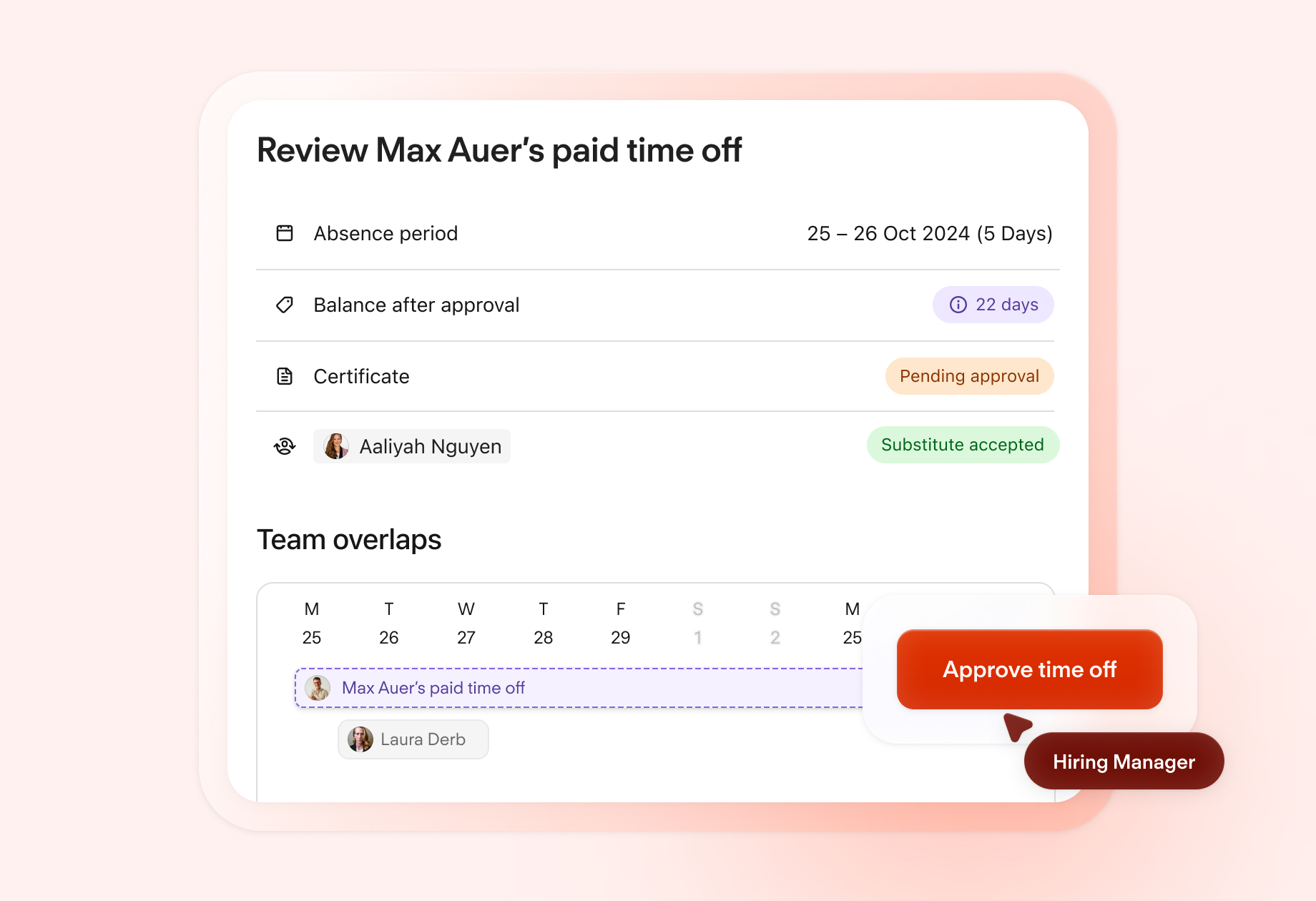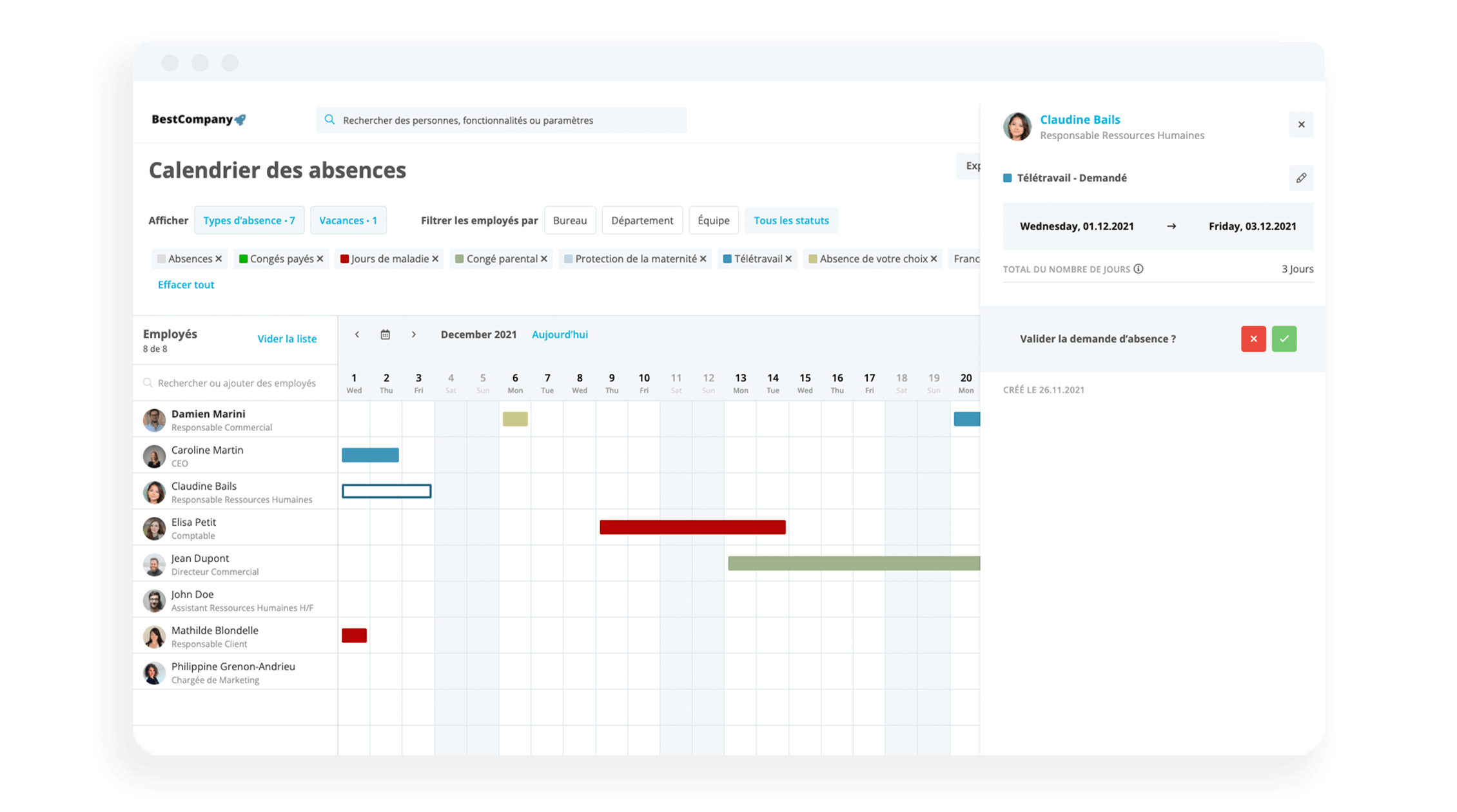Carrying Over Annual Leave in the UK: Everything You Need to Know

Carrying over annual leave isn’t simply better for business, it’s a legal responsibility in the UK. So, what do you do when an employee hasn’t taken all their annual leave in a year? Allow us to break it down for you.
Here’s what you need to know about the process of carrying over annual leave and the legalities involved.
Check out how Personio can help automatically carry over annual leave for your teams.
What is annual leave?
Annual leave is paid time off (PTO) granted to employees as a legal right. In the UK, almost all workers are legally entitled to a minimum of 28 days—or 5.6 weeks—of paid holiday per ‘leave year’.
Paid holiday is also known as statutory leave entitlement, or annual leave, and applies to:
Agency workers
Workers with irregular hours
Workers on zero-hour contracts (AKA casual workers)
Those 5.6 weeks of paid holiday comprise two lengths of time: Four weeks under Regulation 13 and 1.6 weeks under Regulation 13A of the Working Time Regulations 1998 (SI 1998/1833).
Typically, the four weeks of annual leave can’t be carried over into the next year, but the 1.6 weeks can, as long as there’s a written agreement between the employee and employer stating so.
Depending on the employer, a worker’s annual leave may include bank holidays. Employers can also provide workers with additional leave on top of the legal minimum.
Legal rights to annual leave and its carryover in the UK
As detailed in the Working Time Regulations 1998, UK labour law grants employees the automatic right to carry over up to four weeks of unused annual leave.
This is true if it's not reasonably practical to take leave in the current leave year due to reasons beyond their control, such as illness, maternity leave or other extenuating circumstances.
From 1 January 2024, new statutory rules on carryover of holiday apply. These rules allow employees to carry over up to 20 days of their untaken leave into the following leave year, provided it is taken by the end of the period of 18 months starting from the end of the leave year in which it was accrued .
Employers can also agree to allow employees to carry over more than the statutory minimum, but this must be clearly outlined in the employment contract or company policy
When can workers take their leave?
Workers are supposed to take their annual leave within the ‘leave year’ designated by their employer.
A leave year can comprise any 12-month period. While a typical leave year runs from January 1st to December 31st, it could also begin on the first day of a worker’s employment term and end on the one-year anniversary date.
For example, if a worker’s first day at a company was March 7th, 2022, their leave year would start on that day and end on March 7th, 2023.
Motivating employees to take their leave
Encouraging employees to take their annual leave is crucial for both their well-being and the organisation's productivity. Here are some benefits:
For employees:
Improved mental health: Regular breaks help reduce stress and prevent burnout.
Increased productivity: Well-rested employees are more focused and efficient.
Better work-life balance: Taking leave helps employees maintain a healthy balance between work and personal life.
For employers:
Reduced absenteeism: Encouraging leave can reduce the number of sick days taken by employees.
Higher retention rates: Motivated and well-rested employees are more likely to stay with the company.
Enhanced company culture: Promoting leave shows that the company values employee well-being, which can improve overall morale.
How employees accrue annual leave
A worker begins accruing their entitled annual leave on their first day of employment. They may also accrue holiday entitlement while on maternity leave, paternity leave, adoption leave, shared parental leave or another type of statutory leave from work.
These rights are in place for furloughed employees as well. Furloughed employees can continue to accrue their annual leave (and any other holiday they’re entitled to) during their furlough period, as per their employment contract.
Some organisations follow an accrual system, where workers earn a portion of their annual leave throughout the first year of their employment. Essentially, they earn one-twelfth of their annual leave each month until they reach their first work anniversary.
From then on, their annual leave allowance remains the same—unless it’s increased or decreased by their employer due to a change in their position or contract. If a worker leaves their organisation before using all of their accrued statutory holiday entitlement, the employer must compensate them accordingly.
Track Annual Leave Across Your Organisation

Log, track, visualise and report on employee absences in an instant — all from one place.
Tracking Absences With PersonioHow is annual leave calculated?
Below, you’ll find some basic calculations you can follow to determine an employee’s annual leave allowance based on their employment status.
You can also calculate annual leave entitlement for a full leave year or partial leave year using this government-provided calculator.
To calculate the annual leave allowance for a full-time employee, multiply the typical number of days they work per week by the amount of paid holiday they receive per year in weeks.
Example: Kelsey works five days a week and has 6.6 weeks of paid holiday available to him every year.
5 (days worked per week) x 6.6 (weeks of paid holiday) = 33 days of annual leave per year.
Part-time workers are entitled to 5.6 weeks of paid holiday, in proportion to how many hours they work per week. To calculate a part-time worker’s annual leave allowance, multiple the number of days they work per week by 5.6.
Example: If Kim, a part-time employee, works three days a week, she would receive 16.8 days of annual leave per year (3 x 5.6 = 16.8).
If Kim’s employers offered more than the standard 5.6 weeks of paid holiday, her annual leave would be calculated in proportion to that amount.
If a worker doesn’t have a set amount of hours they work per week, you may consider them a casual worker.
A casual worker—also known as a zero-hours worker—works for an organisation on an ad-hoc basis and isn’t permanently on the payroll, but they’re not self-employed. These workers are entitled to a pro-rated minimum of 5.6 weeks’ annual leave after they reach one full leave year with the company.
There are no clear government guidelines on how to convert casual workers’ annual entitlement into days or hours, which would better reflect their employment status. However, one common approach to calculating holiday entitlement for casual workers is to base it on the average number of hours worked over the 12-week period before their leave.
Another common method is the 12.07% method, which is used to determine how much holiday entitlement a casual worker earns per hour.
Example: Sarah is a casual worker and is entitled to 5.6 weeks of paid annual leave per year. In the past week, she’s worked 18 hours. Here’s how to determine how much annual leave she’s accrued during that week:
5.6 (weeks of entitled paid leave) / 46.6 (number of remaining weeks in a year) = 0.12017 x 100 = 12.07%.
This tells us Sarah accrues holiday entitlement at 12.07% per hour.
12.07% of 18 (hours worked) = 2.1726 hours of holiday accrued.
Sarah’s employers could then use this calculation to track her holiday accrual and ensure she reaches her minimum entitlement. It’s important to note that employers cannot round-down the amount of leave their workers receive, but they may round up.
Deducting holiday from carried-over leave
When an employee carries annual leave over to the next year, their employer should deduct their holiday from the amount that expires first.
Example: Sam has one week of annual leave that he’s carrying over into 2023. He now has a total of 6.6 weeks of annual leave (5.6 weeks + one week). When Sam books a week-long holiday, it should be deducted from the one-week carry-over, not the 5.6 weeks of new entitled leave.
How annual leave is carried over
Carrying over annual leave outside of the entitled 5.6 weeks is a privilege. While some employers may allow their workers to carry all of their unused annual leave into the next year, others don’t. In other words, if a worker doesn’t use up their allotted annual leave in one leave year, they lose it.
There are some exceptions, though. Legally, a worker can carry the entire amount of their annual leave over to the next year if they were unable to take it due to maternity, paternity or adoption leave. If a worker wasn’t able to take their annual leave due to sickness, they can carry up to 20 days over to the next leave year.
Some employers may limit how much leave an employee can carry over into the next year. Most commonly, that limit is five business days.
Employers may also set an expiry date for any leave that’s been carried over from the previous year. For example, employees may have to use their carried-over leave within the first three months of the next leave year.
Example: Jim’s employer gives him 30 days of paid annual leave per year, with no restrictions on carried over leave. By the end of the 2022, Jim had only taken 25 days of annual leave. So, those remaining 5 days could carry over to the next year, giving him 35 days of annual leave for 2023.
Irregular hour and part-year workers
For irregular hour and part-year workers, calculating and carrying over annual leave can be more complex. Here are some key points:
Accrual method: From 1 April 2024, holiday entitlement for irregular hours and part-year workers will be calculated as 12.07% of actual hours worked in a pay period.
Carry-over rules: Like regular workers, irregular-hours workers or part-year workers will need to use the leave they have carried over within 18 months, starting from the end of the leave year in which it was accrued.
Examples: If an employee works 160 hours in a pay period, they will accrue 19.31 hours of leave (160 hours x 12.07%).
Annual leave when employment ends
When an employee leaves the company, any accrued but unused annual leave must be paid out. This includes both the leave accrued in the current leave year and any carried-over leave from previous years .
Key points:
Payment in lieu: If an employee has unused leave at the end of their employment, they should be compensated for this untaken holiday.
Calculation: The amount of leave depends on the employee's entitlement and the number of hours worked.
Legal requirements: Employers must ensure they comply with the statutory minimums and any additional agreements outlined in the employment contract.
Do you have a leave management system in place?

The world of work is only becoming more complex. The last thing you should be worrying about is calculating holiday entitlements, tracking them or ensuring you are legally compliant. Allow us to help.
Personio is an all-in-one HR software that helps upgrade your people operations for now and the future. That includes a leave management software that can manage holiday requests, track every kind of leave (from emergencies to sicknesses and bank holidays) alongside all of your other core HR processes.
Over 12,000 customers in the UK and Europe trust us to help. Get in touch with one of our helpful HR experts today, or start your own free trial to give Personio a go right away.
Disclaimer
Disclaimer: We would like to inform you that the contents of our website (including any legal contributions) are for non-binding informational purposes only and does not in any way constitute legal advice. The content of this information cannot and is not intended to replace individual and binding legal advice from e.g. a lawyer that addresses your specific situation. In this respect, all information provided is without guarantee of correctness, completeness and up-to-dateness.
